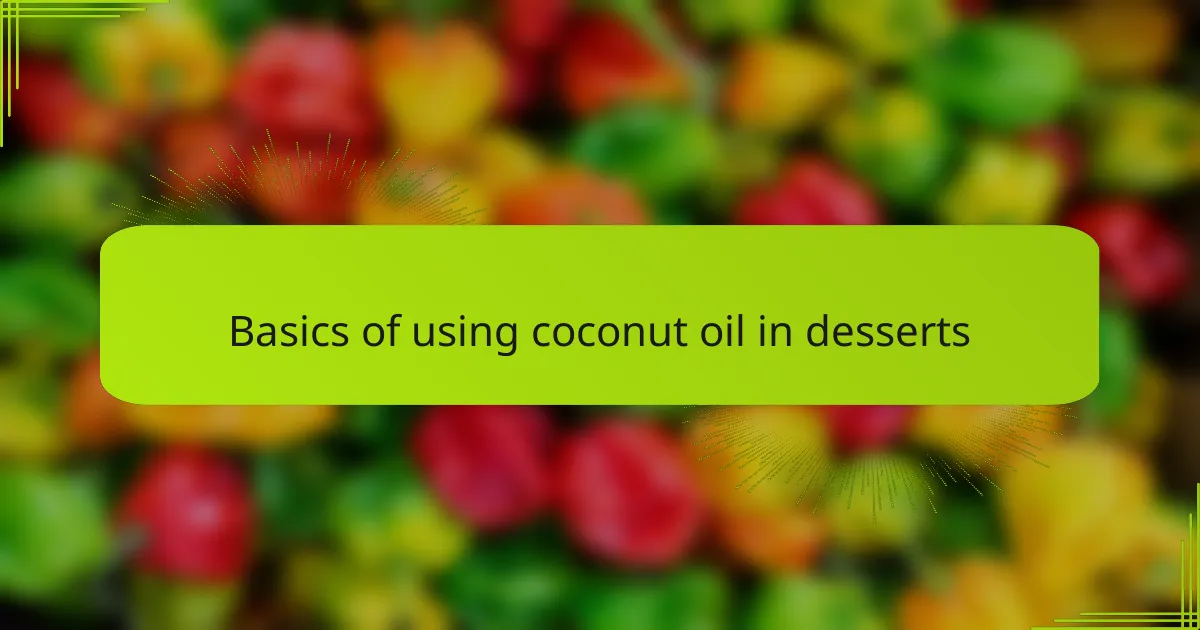Key takeaways
- Coconut oil, especially Nutiva’s, adds a unique tropical flavor and enhances dessert texture without being heavy.
- Nutiva coconut oil’s purity and non-GMO quality provide confidence in using a responsibly sourced product.
- Substituting butter with Nutiva coconut oil is straightforward and can yield lighter, more tender baked goods.
- Incorporating coconut oil can enhance both flavor and appearance in desserts, making them more enjoyable and memorable.

Understanding coconut oil benefits
Coconut oil is more than just a trendy ingredient—I’ve found that it brings a unique richness and depth to my desserts that other oils just can’t match. Have you ever noticed how some fats leave behind a heavy feeling, while coconut oil adds a light, almost tropical touch? That subtle flavor transformation has made my baking stand out in ways I didn’t expect.
Beyond taste, one fascinating benefit I’ve appreciated is its natural heat stability. When I bake with Nutiva coconut oil, I worry less about burning or losing nutrients, which means my desserts stay moist and flavorful every single time. Isn’t it great when an ingredient works as hard as you do in the kitchen?
And there’s something comforting about knowing I’m using a product with potential health perks, like healthy fats that can support energy and brain function. It makes me feel better about indulging in sweets when I understand the ingredients are thoughtfully chosen—don’t you think that knowing what goes into your food adds a little more joy to eating it?

Why choose Nutiva coconut oil
What sets Nutiva coconut oil apart for me is its purity and organic quality. I’ve tried many brands, but Nutiva’s commitment to non-GMO and sustainably sourced coconuts gives me confidence I’m using something both wholesome and responsibly made. Doesn’t it feel good to support products that care about the planet while enhancing your recipes?
I also love how Nutiva’s coconut oil blends seamlessly into my dessert mixtures, whether melting into brownies or whipping into frostings. The smooth texture and clean taste never overpower the other ingredients—just a subtle, natural boost that elevates the final product. Have you ever had an oil that just “disappears” into the batter in the best way possible?
Lastly, the aroma is something I can’t ignore. Nutiva coconut oil fills my kitchen with a gentle, tropical scent that instantly brightens my mood and sparks creativity. It’s amazing how sensory details like smell can turn baking from a task into a joyful ritual, wouldn’t you agree?

Basics of using coconut oil in desserts
Using coconut oil in desserts has a simple magic to it that I didn’t fully appreciate until I started experimenting more. I’ve noticed that substituting butter or other oils with Nutiva coconut oil often yields a smoother texture and a subtle creaminess that feels like an upgrade rather than a compromise. Have you ever tried swapping fats in a recipe and been pleasantly surprised by how it completely changes the mouthfeel?
One of the basics I always keep in mind is the solid-to-liquid transition of coconut oil. Since it’s solid at room temperature and melts around 76°F (24°C), timing matters when mixing it into batters or doughs. For instance, I learned to soften it gently rather than fully melting it, which made my cookies hold together better and have a tender crumb. It’s a small detail, but it transforms the final bite.
I also find that coconut oil plays nicely with sugar, helping it dissolve evenly while imparting a natural sheen to the finished dessert. When making frostings or glazes, I’ll often whisk in melted coconut oil to get that perfect glossy finish that looks as good as it tastes. Isn’t it amazing how the right fat can become an essential part of both flavor and appearance?

How to substitute butter with Nutiva
Substituting butter with Nutiva coconut oil has been a game-changer for me, especially because the conversion is pretty straightforward—I usually replace butter with an equal amount of coconut oil by volume. Have you ever worried about your baked goods turning out greasy or dry after swapping fats? I felt the same way at first, but with coconut oil, the texture often comes out lighter and more tender, which pleasantly surprised me.
One trick I learned along the way is to pay attention to the coconut oil’s form. Since it’s solid at room temperature, I like to soften it just until it’s spreadable, not fully melted, to mimic butter’s consistency. This little step helped me keep the right structure in my cookies and cakes, avoiding the common pitfall of overly dense or oily desserts. Have you noticed how small changes in ingredient texture can make all the difference?
What I also appreciate is the subtle flavor coconut oil adds when replacing butter. Unlike butter’s rich, sometimes heavy taste, Nutiva coconut oil lends a gentle, tropical hint that complements many dessert flavors without overpowering them. That nuance transformed how I think about fat in baking—sometimes, less obvious flavor can make a dessert feel more balanced and intriguing. Have you tried a swap that unexpectedly elevated your recipe?

Personal tips for dessert enhancement
One personal tip I swear by is using Nutiva coconut oil to gently grease my baking pans. It not only prevents sticking but also infuses a subtle coconut aroma that makes the whole kitchen smell inviting. Have you ever noticed how the scent of something cooking can instantly boost your anticipation? That’s exactly the little magic I love bringing to my desserts.
Another trick I’ve found useful is incorporating a small amount of melted coconut oil into my fruit compotes or drizzles before serving. It adds a silky texture and a mild sheen that makes the presentation pop, even for simple desserts. It might sound minor, but those finishing touches can really turn an everyday treat into a memorable experience—don’t you agree?
Sometimes, I like to experiment by swapping part of the oil in my recipes with Nutiva coconut oil rather than doing a full replacement. This balance lets me enjoy the enhanced flavor and moisture without overwhelming the other ingredients. Have you tried gradual swaps in your baking? It’s a fun way to explore new flavors while keeping your favorites intact.

Favorite Nutiva dessert recipes
When it comes to my favorite Nutiva dessert recipes, one that always stands out is my coconut oil chocolate brownies. I love how the Nutiva coconut oil lends them a moist, tender crumb without being heavy. Have you ever bitten into a brownie that feels rich yet light? That’s exactly the balance Nutiva helps me achieve every time.
Another go-to is a simple coconut oil blondie infused with vanilla and chopped nuts. The subtle tropical hint from Nutiva elevates a classic treat into something unexpectedly delightful. I remember the first time I tried this recipe—I was surprised at how that gentle coconut flavor didn’t overpower, but instead, quietly stole the show.
I also enjoy whipping up no-bake coconut oil energy balls packed with oats, cacao, and a touch of honey. Using Nutiva coconut oil not only binds everything perfectly but also adds a silky texture that’s hard to beat. Have you ever made a dessert that’s both satisfying and nourishing? That’s the kind of recipe I keep coming back to.

Tips for perfect texture and flavor
Getting the texture just right with Nutiva coconut oil has been a bit of an adventure for me. I’ve found that softly solid coconut oil—think room temperature but still firm—helps create that tender crumb in cakes and cookies without them turning greasy or dense. Have you ever noticed how the state of your fat can totally change the way a dessert feels? It’s such a simple detail, yet it makes all the difference.
Flavor-wise, I love how Nutiva coconut oil adds a gentle, tropical undertone that doesn’t shout, but quietly enhances everything else. When I first tried it in my chocolate cake, the subtle coconut hint rounded out the richness perfectly, making each bite feel just a touch more special. Isn’t it amazing how a tiny flavor note can elevate a whole dessert?
One more tip I swear by is balancing the amount you use—too much coconut oil can overwhelm, but the right amount keeps things moist and flavorful without being heavy. I like to experiment by mixing Nutiva oil with other fats, which lets me enjoy the best of both worlds. Have you ever played around with fat blends in baking? It’s a small tweak that turns into a big win for texture and taste.




